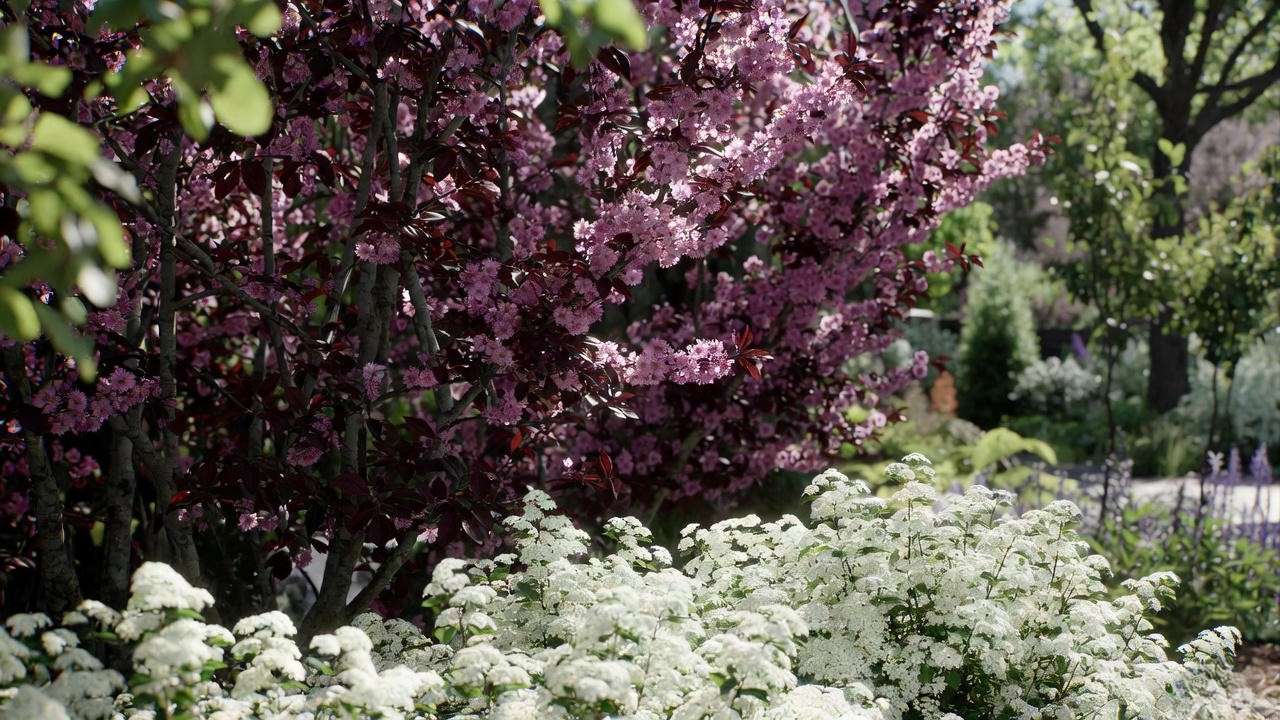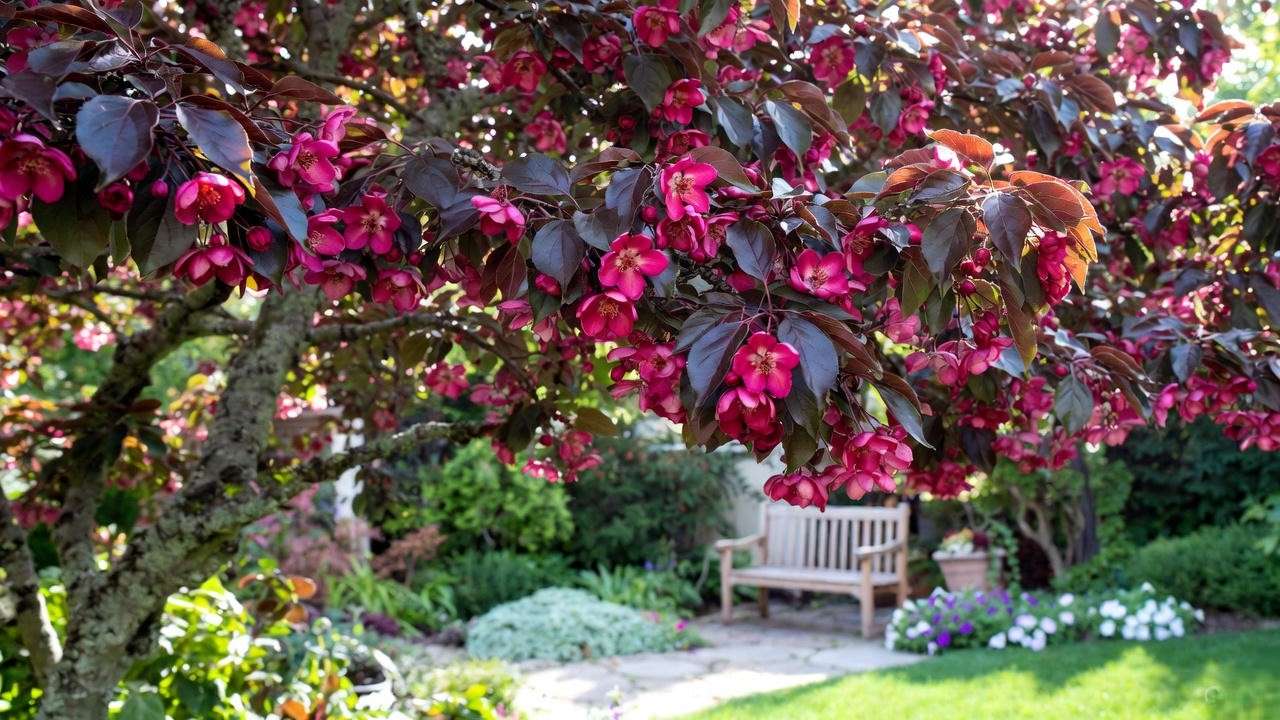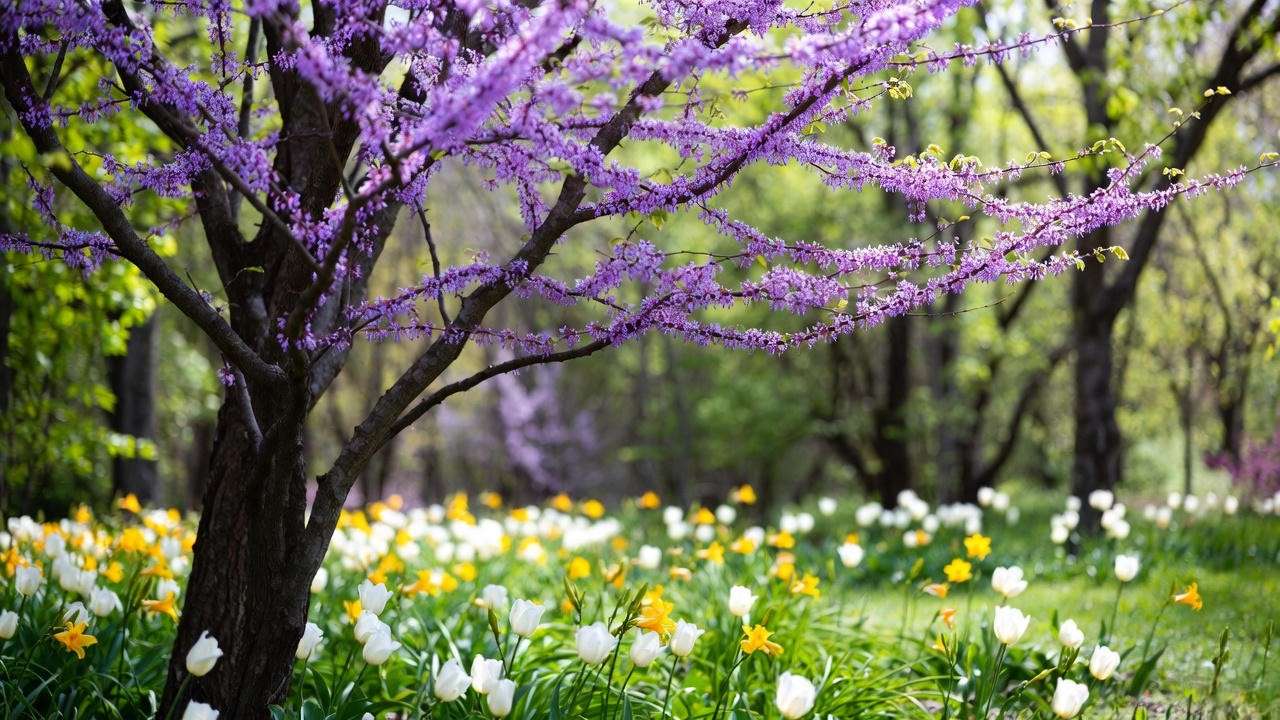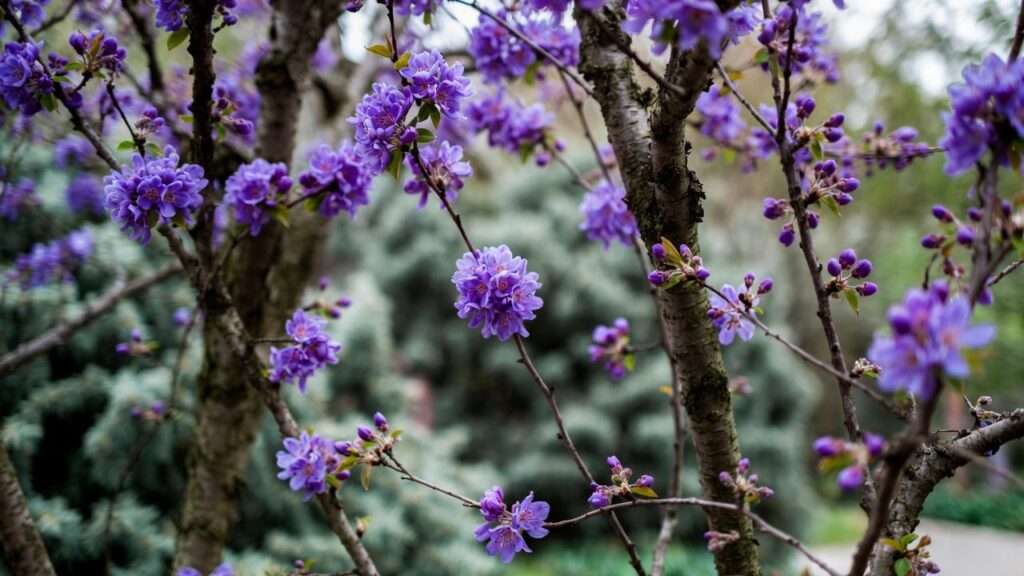Picture your garden awash in vibrant purple blooms, catching every passerby’s eye and filling your heart with joy each spring. Springtime purple flowering trees are the key to creating a breathtaking landscape that’s both beautiful and functional. These stunning trees not only elevate your garden’s aesthetic but also support pollinators, boost curb appeal, and create a serene oasis. Whether you’re a novice gardener or a seasoned landscaper, this guide will help you choose the perfect springtime purple flowering tree to transform your outdoor space. In this comprehensive article, we’ll explore the top five springtime purple flowering trees, share expert care tips, offer design inspiration, and answer common questions to ensure your garden thrives. Backed by over a decade of horticulture expertise and trusted botanical sources, this guide is your roadmap to a vibrant spring garden! 🌿
Why Choose Springtime Purple Flowering Trees? 🌼
Springtime purple flowering trees are more than just eye candy—they’re a game-changer for any garden. Their vivid blooms and unique foliage make them a must-have for homeowners and garden enthusiasts.
Aesthetic Appeal and Emotional Impact 😍
Purple is a color that captivates. It evokes feelings of calm, creativity, and luxury, making it a perfect choice for gardens. A springtime purple flowering tree can serve as a striking focal point, whether you’re aiming for a modern minimalist look, a cozy cottage vibe, or a bold tropical escape. For example, imagine a Jacaranda’s lavender blooms cascading over a sleek patio or an Eastern Redbud’s delicate flowers softening a rustic fence line. These trees create emotional connections, turning your garden into a sanctuary.
Environmental Benefits 🐝
Beyond beauty, these trees are environmental superstars. Their nectar-rich flowers attract bees, butterflies, and hummingbirds, supporting local ecosystems. Many, like the Eastern Redbud, are native to North America, making them ideal for sustainable landscaping. They also improve air quality by filtering pollutants and provide cooling shade, reducing energy costs in warm climates.
Practical Advantages 🏡
A well-chosen springtime purple flowering tree can increase your property’s value by enhancing curb appeal. Realtors often note that mature, flowering trees are a major selling point for homes. Plus, many of these trees, like the Crabapple ‘Royalty,’ are low-maintenance, saving you time and effort. Whether you have a sprawling lawn or a tiny urban plot, there’s a purple flowering tree to fit your needs.
Top 5 Springtime Purple Flowering Trees for Your Garden 🌸
Let’s dive into the stars of the show: the top five springtime purple flowering trees that will elevate your garden. Each comes with a detailed profile, care tips, and planting advice to help you succeed.
1. Eastern Redbud (Cercis canadensis) 💜
Description: The Eastern Redbud is a compact deciduous tree, growing 20-30 feet tall, with heart-shaped leaves and clusters of purple-pink flowers that bloom in early spring before the foliage appears.
Why It’s Great: This native North American tree is a springtime favorite, offering vibrant blooms in USDA Zones 4-9. Its adaptability to various soil types and climates makes it a versatile choice for many gardeners.
Care Tips:
- Light: Full sun to partial shade.
- Soil: Well-drained, slightly acidic to neutral soil.
- Water: Moderate; avoid overwatering to prevent root rot.
- Pruning: Minimal, but remove dead branches in late winter.
Pros/Cons:
- Pros: Low maintenance, drought-tolerant once established, attracts pollinators.
- Cons: Susceptible to overwatering and fungal diseases in humid climates.
Planting Advice: Ideal for small yards, patios, or as an understory tree in larger landscapes. Plant near a walkway to showcase its early spring blooms. Pair with spring bulbs like tulips for a colorful display.

2. Jacaranda (Jacaranda mimosifolia) 🌴
Description: Known for its fern-like leaves and trumpet-shaped lavender-blue flowers, the Jacaranda can reach 40 feet, creating a tropical paradise in warm climates.
Why It’s Great: Its long bloom season and stunning canopy make it a showstopper in USDA Zones 9-11. Perfect for coastal or subtropical gardens, it adds an exotic flair.
Care Tips:
- Light: Full sun for best flowering.
- Soil: Well-drained, sandy loam.
- Water: Moderate; reduce in winter to prevent root issues.
- Protection: Shield from frost, as it’s not cold-hardy.
Pros/Cons:
- Pros: Gorgeous blooms, fast-growing, shade provider.
- Cons: Messy (falling flowers), not suitable for cold climates.
Planting Advice: Best for warm regions like Southern California or Florida. Use as a standalone specimen in large yards or along driveways for dramatic effect. Avoid planting near pools due to flower drop.
3. Purple Leaf Plum (Prunus cerasifera) 🍒
Description: This small tree (15-25 feet) boasts deep purple foliage and pinkish-purple spring flowers, followed by edible plums in some varieties.
Why It’s Great: Its year-round color and compact size make it ideal for urban gardens or hedges in USDA Zones 5-9. The flowers and fruit add multi-season interest.
Care Tips:
- Light: Full sun for vibrant foliage.
- Soil: Well-drained, fertile soil.
- Water: Regular, especially during establishment.
- Pruning: Shape in late winter to maintain structure.
Pros/Cons:
- Pros: Compact, edible fruit, striking foliage.
- Cons: Prone to aphids and plum curculio.
Planting Advice: Use as a hedge, accent tree, or in mixed borders. Pair with white-flowering shrubs like spirea for contrast. Monitor for pests and treat with organic sprays if needed.

4. Empress Tree (Paulownia tomentosa) 👑
Description: A fast-growing tree (up to 50 feet) with large heart-shaped leaves and fragrant lavender flowers in spring, the Empress Tree is a bold choice.
Why It’s Great: Its dramatic blooms and rapid growth make it a shade provider in USDA Zones 5-9. Perfect for large properties needing quick impact.
Care Tips:
- Light: Full sun.
- Soil: Fertile, well-drained; tolerates poor soils.
- Water: Moderate; drought-tolerant once mature.
- Control: Prune to manage size and remove suckers to prevent invasiveness.
Pros/Cons:
- Pros: Fast-growing, fragrant flowers, shade provider.
- Cons: Potentially invasive in some regions; check local regulations.
Planting Advice: Best for large estates or rural properties. Avoid planting near natural areas due to its invasive potential. Consult your local extension service before planting.

5. Crabapple ‘Royalty’ (Malus ‘Royalty’) 🍎
Description: A compact tree (15-20 feet) with deep purple leaves, magenta spring flowers, and small red fruit, offering all-season beauty.
Why It’s Great: Its wildlife-friendly fruit and compact size suit small gardens in USDA Zones 4-8. The foliage and blooms create a rich, regal look.
Care Tips:
- Light: Full sun for best color.
- Soil: Well-drained, slightly acidic.
- Water: Regular; avoid waterlogged roots.
- Monitoring: Watch for apple scab or fire blight; choose resistant cultivars.
Pros/Cons:
- Pros: Compact, wildlife-friendly, multi-season interest.
- Cons: Susceptible to diseases if not properly managed.
Planting Advice: Perfect for patios, courtyards, or mixed borders. Plant near bird feeders to attract songbirds. Pair with low-growing perennials like catmint for a polished look.

How to Choose the Right Purple Flowering Tree for Your Garden 🌺
Selecting the perfect springtime purple flowering tree depends on your climate, space, and aesthetic goals. Here’s how to make an informed choice.
Consider Your Climate and USDA Zone ❄️☀️
Match your tree to your region’s USDA Hardiness Zone. For colder climates (Zones 4-8), Eastern Redbud or Crabapple ‘Royalty’ are excellent choices. In warmer zones (9-11), Jacaranda thrives. Check the USDA Plant Hardiness Zone Map for accuracy.
Evaluate Space and Size 📏
Small yards benefit from compact trees like Purple Leaf Plum or Crabapple ‘Royalty.’ For expansive properties, the Empress Tree or Jacaranda can make a bold statement. Measure your space and consider mature tree size to avoid overcrowding.
Match with Your Garden Style 🎨
Choose a tree that complements your design:
- Modern: Purple Leaf Plum’s sleek foliage.
- Cottage: Eastern Redbud’s soft, romantic blooms.
- Tropical: Jacaranda’s vibrant canopy.
Maintenance Level and Time Commitment ⏰
Busy gardeners will appreciate low-maintenance options like Eastern Redbud or Crabapple ‘Royalty.’ The Empress Tree requires more effort due to its growth rate and potential invasiveness.
Expert Care Tips for Springtime Purple Flowering Trees 🌱
Once you’ve chosen your springtime purple flowering tree, proper care ensures it thrives and dazzles year after year. Here’s how to keep your tree healthy, from planting to ongoing maintenance.
Planting Guidelines 🌳
- Timing: Plant in early spring or fall for optimal root establishment. Avoid summer heat or frozen winter ground.
- Steps:
- Dig a hole twice as wide and as deep as the root ball.
- Amend soil with compost for nutrient-poor sites, but avoid heavy fertilization at planting.
- Place the tree, ensuring the root flare is level with the ground.
- Backfill, water thoroughly, and add a 2-3 inch layer of mulch, keeping it away from the trunk.
- Expert Tip: Water deeply once a week for the first year to encourage strong roots.
Watering and Fertilizing 💧
- Watering:
- Eastern Redbud and Crabapple ‘Royalty’: Moderate water, allowing soil to dry slightly between sessions.
- Jacaranda: Reduce watering in winter to prevent root rot.
- Purple Leaf Plum and Empress Tree: Regular water during establishment, drought-tolerant once mature.
- Fertilizing:
- Use a balanced, slow-release fertilizer (e.g., 10-10-10) in early spring.
- Avoid over-fertilizing, which can reduce blooms and stress the tree.
- Pro Insight: Test your soil’s pH annually, as most purple flowering trees prefer slightly acidic to neutral conditions (pH 6.0-7.0).
Pruning and Maintenance ✂️
- When to Prune: Late winter or early spring before new growth, except for Jacaranda, which benefits from post-bloom pruning.
- How to Prune:
- Remove dead, damaged, or crossing branches.
- Shape for aesthetics, but avoid heavy cuts that stress the tree.
- For Empress Tree, prune aggressively to control size if needed.
- Common Issues:
- Pests: Purple Leaf Plum may attract aphids; use neem oil for organic control.
- Diseases: Crabapple ‘Royalty’ is prone to apple scab; choose resistant cultivars and ensure good air circulation.
- Expert Tip: Sanitize pruning tools with alcohol to prevent disease spread.
Winter Protection 🥶
- Mulching: Apply a 3-4 inch layer of organic mulch (e.g., wood chips) around the base to insulate roots.
- Wrapping: For young trees or frost-sensitive species like Jacaranda, wrap trunks with burlap in colder climates.
- Frost Protection: Cover Jacaranda with frost cloth during unexpected cold snaps in Zones 9-11.
- Pro Insight: Avoid fertilizing late in the season, as it promotes tender growth vulnerable to frost.
Design Ideas: Incorporating Purple Flowering Trees in Your Landscape 🖌️
Springtime purple flowering trees are versatile, fitting into various garden styles. Here are creative ways to showcase them.
Focal Points and Statement Trees 🌟
- How: Use a Jacaranda or Empress Tree as a centerpiece in a large lawn or courtyard.
- Example: Plant a Jacaranda in the center of a circular gravel patio, surrounded by low-growing succulents for a modern-tropical vibe.
- Tip: Highlight with subtle landscape lighting to accentuate blooms at dusk.
Mixed Borders and Companion Plants 🌺
- How: Pair with complementary plants to enhance the tree’s beauty.
- Examples:
- Eastern Redbud with white tulips or lavender for a cottage look.
- Purple Leaf Plum with yellow daylilies for bold contrast.
- Tip: Space companion plants 3-5 feet from the trunk to avoid root competition.

Urban and Small-Space Gardens 🏙️
- How: Opt for compact trees like Crabapple ‘Royalty’ or Purple Leaf Plum in courtyards, patios, or narrow lots.
- Example: Plant a Crabapple ‘Royalty’ in a large container for a balcony, paired with trailing petunias.
- Tip: Use raised beds to improve drainage in urban soils.
Common Mistakes to Avoid When Growing Purple Flowering Trees 🚫
Even experienced gardeners can make missteps. Avoid these pitfalls to ensure your tree thrives:
- Overwatering: Leads to root rot, especially in Eastern Redbud and Jacaranda. Check soil moisture before watering.
- Poor Site Selection: Planting in heavy shade reduces blooms (e.g., Purple Leaf Plum needs full sun).
- Ignoring Invasiveness: Empress Tree can spread aggressively; confirm it’s safe for your region with your local extension service.
- Neglecting Pruning: Skipping annual pruning can lead to weak branches and fewer flowers.
Environmental and Community Impact of Purple Flowering Trees 🌍
Springtime purple flowering trees do more than beautify your yard—they benefit the planet and your neighborhood.
- Pollinator Support: Their nectar-rich blooms attract bees, butterflies, and hummingbirds, boosting biodiversity. For example, Eastern Redbud is a favorite of native pollinators.
- Community Benefits: A vibrant tree enhances neighborhood aesthetics, fostering pride and connection. Studies show green spaces improve mental health and property values.
- Sustainability Tip: Opt for native species like Eastern Redbud to conserve water and support local ecosystems. Avoid potentially invasive trees like Empress Tree in sensitive areas.
FAQs About Springtime Purple Flowering Trees ❓
Q1: Which purple flowering tree is best for small gardens? A: Crabapple ‘Royalty’ or Purple Leaf Plum are perfect due to their compact size (15-25 feet) and adaptability to urban spaces.
Q2: Are these trees hard to maintain? A: Most, like Eastern Redbud and Crabapple ‘Royalty,’ are low-maintenance with proper site selection and basic care. Regular monitoring prevents issues.
Q3: Can I grow Jacaranda in a cold climate? A: No, Jacaranda thrives in Zones 9-11. For colder climates (Zones 4-8), choose Eastern Redbud or Crabapple ‘Royalty.’
Q4: Do these trees attract pests? A: Some, like Purple Leaf Plum, may attract aphids or plum curculio. Use organic treatments and monitor regularly.
Q5: How fast do these trees grow? A: Empress Tree is the fastest, reaching 10-15 feet in a year. Others, like Eastern Redbud, take 3-5 years to mature.
Conclusion: Create Your Dream Garden with Purple Flowering Trees 🌈
Springtime purple flowering trees are the ultimate way to transform your garden into a vibrant, welcoming haven. From the delicate blooms of the Eastern Redbud to the tropical allure of the Jacaranda, these trees offer beauty, environmental benefits, and versatility for every garden style. By choosing the right tree for your climate and space, following our expert care tips, and incorporating creative design ideas, you’ll create a springtime masterpiece that lasts for years. Start today—select your favorite purple flowering tree, plant with confidence, and watch your garden bloom with color and life. Share your favorite tree or ask for personalized advice in the comments below! 🌸













